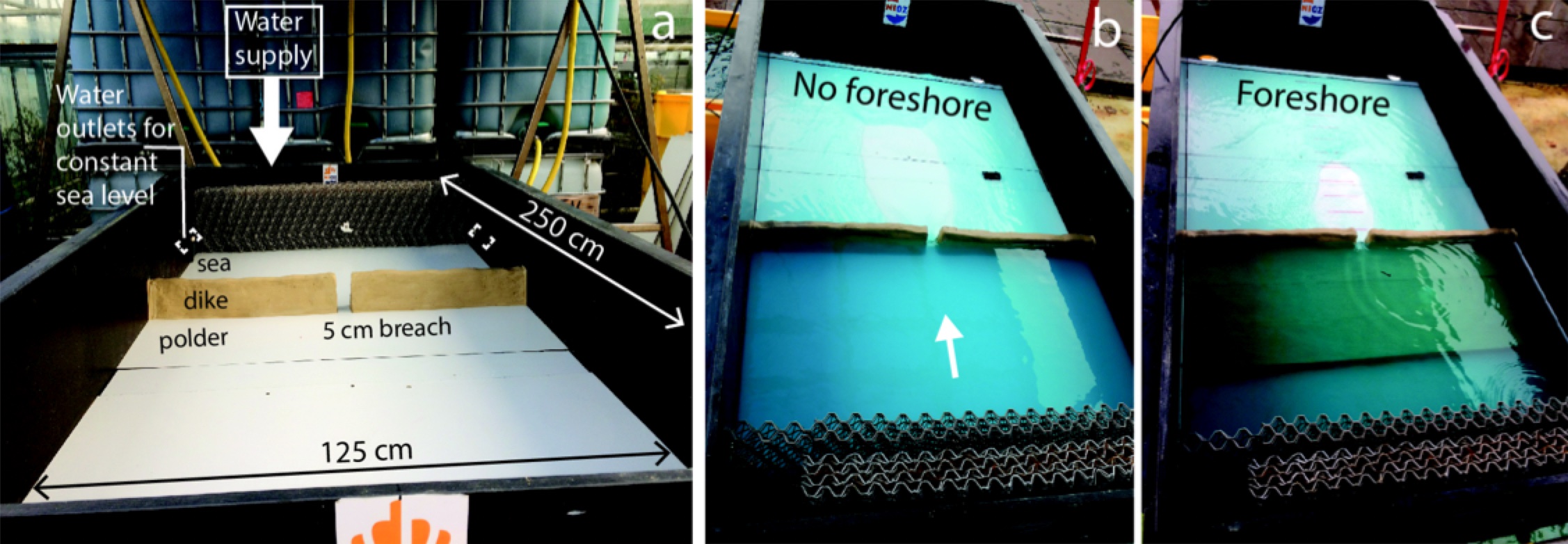Kim van den Hoven1*, Jantsje M. van Loon-Steensma1, Jim van Belzen2, Tjeerd J. Bouma2,3, Maarten G. Kleinhans3
1 Wageningen University, Water Systems and Global Change group
2 NIOZ, Dept. of Estuarine and Delta Systems
3 Utrecht University, Dept. of Physical Geography
*corresponding author:
Introduction
Climate-proof coastal protection includes flood protection by dikes and foreshores. Historical data and initial modelling show the presence of a foreshore limits the chance and consequences of a dike breach (Zhu et al., 2020). We aim to provide quantitative lab evidence for the influence of foreshore dimensions on polder inundation during a dike breach.
Methods
A dike breach event was simulated in a scaled flume. Inside the flume, a sea, dike and polder area were created (details in Figure 1). A foreshore was placed in front of the clay dike. Foreshores differed in height (3.5 cm for low marsh and 5.0 cm for high marsh), width (15, 30, 45, or 60 cm), and material (sand or TRESPA). Sae level was kept constant at 10 cm, without waves. The dike had a fixed breach of 5.0 cm wide. A total of 24 runs were conducted, including two control runs without a foreshore. Data was collected using depth sensors for water depth monitoring and cameras for visual observation.
Results
Preliminary results show that in a lab setting the presence of a foreshore reduces water flow into a polder during a dike breach (Figure 1). Reduced flow velocity and discharge lead to slower polder inundation. This gives more evacuation time for a dike breach with foreshore compared to a dike breach without a foreshore. Mainly foreshore height is important, while differing foreshore width has little influence. Further analysis will be presented to show it is useful to connect the foreshore and dike for climate-proof flood protection, even in case of a dike breach.

Figure 1: Flume set-up (a). Water flows from the sea into the polder and is stored underneath the flume. Compared to a dike without a foreshore (b), foreshore presence (c) reduces flow velocity and discharge into the polder during a dike breach (image courtesy: Kim van den Hoven).
References
Zhu, Z., V. Vuik, P.J. Visser, T. Soens, B. van Wesenbeeck, J. van de Koppel, S.N. Jonkman, S. Temmerman & T.J. Bouma (2020). Historic storms and the hidden value of coastal wetlands for nature-based flood defence. Nature Sustainability, 3(10), 853-862. doi:10.1038/s41893-020-0556-z
I. Surname1*, F.N. Another-Surname2 , Y. Next-Surname2
1 University Name, Country; 2 Organization Name, Country
* Corresponding author: mail.name@organization.org


